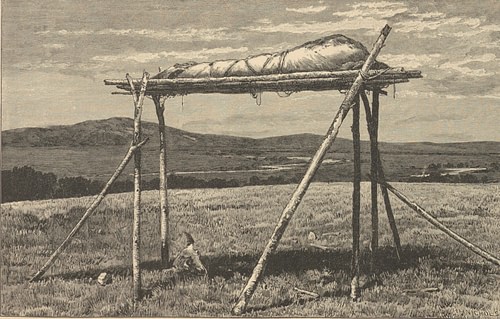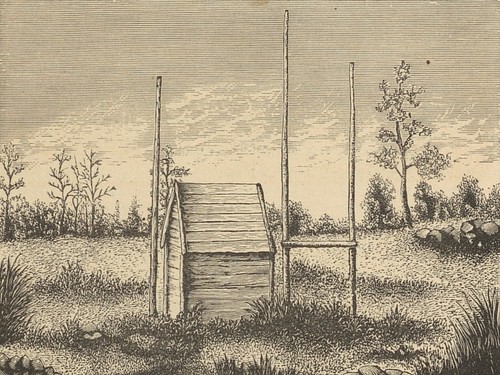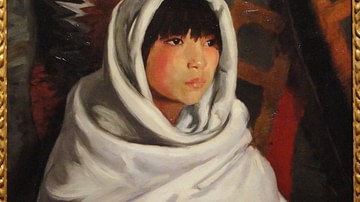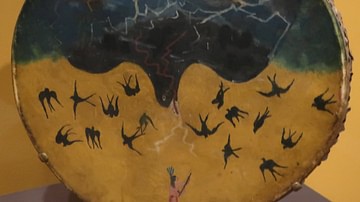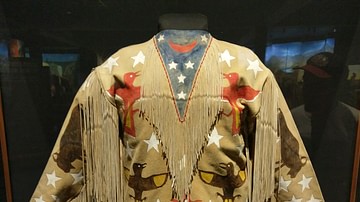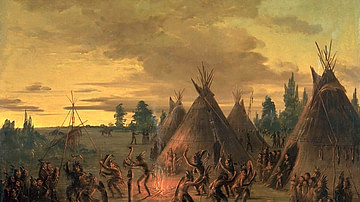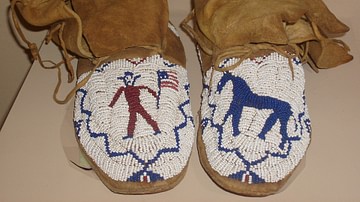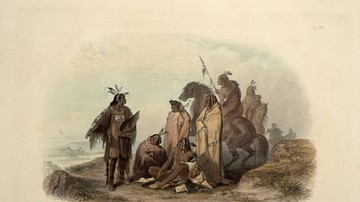A Teton Ghost Story is a tale from the Native American Teton (Tetonwan) of the Oceti Sakowin (People of the Seven Council Fires), better known as the Sioux, on one of the possibilities of the state of the soul after death and how the living might interact with such a spirit.
It is only one of many Native American ghost stories and, like the others, is open to several different interpretations. The Sioux did not fear the spirits of the dead like some other nations (such as the Navajo) but understood the potential danger of interacting with them as the dead, who were thought to be omniscient, might impart some knowledge to the living which they should not have or, perhaps, might lead them to the land of the dead, cause sickness that led to death or, if the spirit happened to be especially angry and powerful, bring misfortune on the whole community.
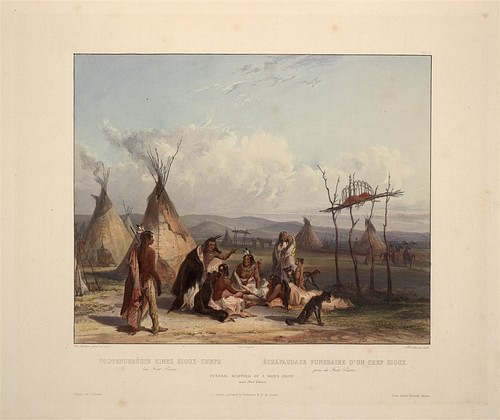
In this story, a young Teton hunter encounters the ghost of a young woman who draws him away from his village and his original intention to marry the chief's daughter, and he follows her until he becomes a ghost himself. Whether this encounter was good or bad for the hunter depends on one's interpretation of how his life unfolds afterwards, but from the commonly held Native American understanding of the value of the community over the wishes or desires of the individual, it may have been recognized as unfortunate in that the village lost a promising hunter and the chief's daughter a prospective husband. At the same time, however, the story may have served as consolation for those in the audience who had lost loved ones but had never been able to find a body or reach closure on that loss.
The Teton Sioux
The nation now known to non-Natives as the Sioux call themselves Oceti Sakowin or Oceti Sakowin Oyate (People of the Seven Council Fires Nation) and is originally comprised of seven distinct Native American nations:
- Mdewakanton
- Sisseton (also as Sistonwan)
- Teton (also as Tetonwan)
- Wahpekute
- Wahpeton (also as Wahpetonwan)
- Yankton (also as Ihanktown)
- Yanktonai (also as Ihanktowana)
Scholar Michael G. Johnson notes:
[The Teton Sioux] was the largest and most powerful of all the original seven branches of the Dakota or Sioux Indians. In fact, they outnumbered the other six tribes together. They became the Western Sioux or, in their own dialect, Lakota, following their migration onto the High Plains in the late 18th and early 19th centuries. (132)
Johnson also notes how, for the Teton Sioux, "burial was invariably of the scaffold type" in which the corpse was raised on a funereal bed supported by posts to allow it to decompose and release the spirit (or spirits) that animated it while the person was alive. The corpse would remain on the scaffold in the open air until wild animals and weather, as well as time, had reduced the body to bare bones. At that point, unless some special rites had been enacted such as the Keeping of the Soul, the spirit of the dead person would move on toward the realm of the dead in the afterlife. Sometimes, but not usually, the dead would be enclosed in a special lodge or 'house', but the corpse would often still be raised on a scaffold.
Afterlife & Ghosts
Native American ghost stories developed from the belief that the soul (or, according to some belief systems, souls) that animated a living human being survived bodily death and continued to exist, either around the body they had inhabited (until it decomposed or was burned) or the places they had known in life. How these spirits were understood differed, often significantly, from nation to nation. Scholar Larry J. Zimmerman comments:
Although beliefs about death and the customs and rituals surrounding bereavement are varied among Native Americans, certain common themes emerge – for example, most groups thought that the dead represented a danger to the living, and therefore the deceased were treated with respect and caution. Almost all Indian peoples believed in some plane of existence beyond the realm of the living, but descriptions of the afterlife differed greatly, and the issue of what happens to the soul after death was a highly complex one for many tribes. (246)
Some nations, like the Mandan, believe that each individual has multiple souls, in their case, four, in others two, and that at least one of these souls remains around the body after death while the other journeys on into the afterlife and, according to some stories, waits for the second soul to join them. The vision of the afterlife differs between nations just as much as any other cultural aspect and, in some, like the Sioux, it might be a mirror image of the life one had known on earth, while to others, it was simply a pause before one was reincarnated, and to still others, it was an upside-down-world where rivers ran backwards, people spoke gibberish, and dances turned the wrong way with the wrong steps. Whatever vision of the afterlife a community had, it was – and is – understood the dead belonged there, not the living, and that encounters with a spirit – except under certain circumstances – brought bad luck.
A spirit of one's ancestor or recently deceased relative who appeared in a dream or a vision to impart some vital information, advice, or direction was always welcomed, but encountering an apparition, especially of a person one did not know, usually brought misfortune unless some deal was struck with the ghost.
The Man Who Wrestled with a Ghost
In the Teton story, The Man Who Wrested with a Ghost, for example, a young warrior on a mission to kill his enemies and steal their horses encounters two ghosts in the woods. The first is the ghost of a woman who appears "as in olden days" wearing a kind of outdated clothing and jewelry, her face hidden by a robe of buffalo hide (Jackson, 334). The warrior pretends to be dead, and the ghost raises his foot and drops it three times, as if to make sure, before drawing out her knife to cut it off. When the warrior yells at her, she runs off into the woods and disappears. This episode illustrates the kind of danger a ghost might present to the living: taking a trophy to bring back to the spirit world.
The next night, the young warrior encounters the ghost of a man who asks him for food. The young man says he has none, but the ghost knows he is lying – because ghosts know everything – and so they share a meal and then smoke the young man's pipe together in friendship and communion. When they are finished, the ghost tells the warrior that they must wrestle; if the young man bests him, his mission will be successful but if the ghost wins, the mission will fail. The warrior defeats the ghost and goes on to kill his enemies and take their horses. The story ends with the line, "It came out just as the ghost said. That is why people believe what ghosts say" (Jackson, 335).
Neither episode is presented as fantasy or a dream but as an actual occurrence, and both present a common understanding of ghosts. In the second episode, by establishing a bond with the spirit and then submitting to a test of spiritual and physical strength, the young warrior is assured of success in his mission. Here, the young man responds to the spirit with respectful interaction, even though he initially lies about having no food, while, with the first ghost, by pretending to be dead, he rejects any such possibility.
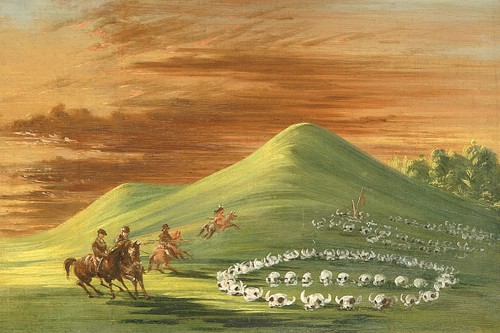
The story suggests that the first haunting may have been caused by the young man making camp near the burial place of the female ghost's body, and this, coupled with his response to her, shows a lack of respect for the dead, and so he risks losing his foot as a trophy to an angry ghost. In the second episode, however, the respect and strength he shows is rewarded by the prediction of his success. One could, therefore, interact with a ghost and experience good luck but this was not often the case, and further, what constituted 'good luck' depends on one's interpretation of the story.
In A Teton Ghost Story, the young hunter's interaction with the ghost of the young woman is different from either of these. No disrespect is shown, and no deal is clearly struck; the young hunter meets the ghost and, afterwards, his life is never the same. Whether that life is better or worse than what he would have had prior to the encounter is left up to the audience to decide.
Text
The following text comes from Voices of the Winds: Native American Legends by Margot Edmonds and Ella Clark, taken from the J. O. Dorsey translation of the original Teton tale.
The Teton band flourished, and its people were healthy and strong because they ate plenty of buffalo meat. Usually when they camped for the night, a crier would go among the lodges and call:
"There will be many buffalo tomorrow. Be on the alert!"
One day after the Tetons returned to their camp from a hard buffalo hunt, a young man announced that he wished to marry the most beautiful girl in the tribe, the Chief's daughter.
Her father said, "I will not give you my permission until you bring me many horses." So, the young Indian set out in search of many wild horses, hoping to please the Chief and win his beautiful daughter for his bride.
While the young brave was away, his tribe abandoned their regular campsite and moved elsewhere. Later, the young Indian returned to the deserted camp with several captured horses. As it was late in the day, he thought he would take shelter nearby in a solitary lodge.
At first, he could not find a doorway into the lodge, because the sides were covered halfway up with sod. Finally, he managed to make an entrance. Inside were four high posts that had been driven into the ground.
The posts supported a kind of burial bed. On the bed lay a woman whose clothes were ornamented with elk's teeth. She turned her head looking down at the young Teton brave. He immediately recognized her as a member of his tribe–but now she was a Woman Ghost! They stayed there for a long time, and she became his wife.
One day he said to himself, "I think I will go on a buffalo hunt." Although he did not speak aloud, the Ghost Woman knew his thoughts and said, "You are hungry for buffalo meat? Mount your horse and ride back to the bluffs.
"When you come to the buffalo herd, rush into the center of them and shoot the fattest one. Bring home the hide and buffalo meat. Roast the meat and bring me a share before you eat yours."
The young Teton Indian brave left and followed Ghost Woman's instructions. When he reached the valley, he came to a large herd of buffalo. He charged his horse at full speed into the middle of them and shot the fattest one. He skinned it and cut up the meat, carrying the robe and meat upon his packhorse. He skewered a large piece of meat and roasted it until it was cooked enough, then he took it to Ghost Woman, who was standing in the center of the lodge.
Her husband was startled to see her standing there. Rows and rows of beautiful beadwork decorated her leather clothing. Already knowing what the young brave was thinking she said, "Please do not be afraid of me!
From that time on, they talked freely and planned what they would like to do. The young Indian brave said, "Why don't we begin our life together like our parents did when they were first married?"
But the Ghost Woman replied, "No, no, that would never do, because we will need to pitch our tent during the day and travel by night." The young brave wondered about this arrangement.
That is how it happened that they travelled at night. Ghost Woman walked ahead with her head covered, never saying a word to her husband as they travelled. Her legs were invisible. She made no noise as she floated along, ghostlike.
Whenever the young Teton Indian brave thought about anything, Ghost Woman already knew what it was that he had in his mind. This is why the Teton Indians say, "Beware of Ghosts because Ghosts know all things."
They say Ghosts know when the winds blow and which ones. Ghosts know when there will be snow. Ghosts know when there will be thunder and lightning. Ghosts are glad when the winds blow, because they can float along more swiftly as they travel from place to place.
This is the way Teton Ghost Woman and the young Teton brave lived. Their tribal people never found them again. The Chief's daughter wondered why her young brave never returned to her.
Finally, the young brave also became a Teton Ghost, floating along with the Teton Ghost Woman, every night, forever.
Conclusion
The lodge the young man encounters is a form of funerary rite known as a house burial in which the corpse was interred in a house built expressly for that purpose, although the dead were also buried below the ground of the house they had lived in. A house burial in which the lodge had been built purposefully as a tomb often also included scaffold burial where the corpse was raised off the ground on a platform supported by posts where it remained until it decomposed, and the spirit then left it to journey on to the afterlife. The young hunter could be said to be disrespecting the tomb, but the story is careful to note that his people have moved on while he has been away, and he mistakes the house burial for a common lodge he could take shelter in.
Once inside, he encounters no decomposing corpse on the scaffold but a young woman of his tribe who he seems to instantly fall in love with “and she became his wife.” The ghost-woman teaches him how to become an even better hunter than he was before and the two of them begin a life together as a couple. The story could be seen to end on a “happily ever after” note except for the fact that the young hunter breaks several taboos of Teton culture. He enters the place of the dead without authorization or knowledge of the deceased, embraces a relationship with a ghost, and deserts his community to follow a phantom. At the same time, however, in the beginning of the story, the young hunter wanted a wife, and, at the end, he has a wife he remains with “every night, forever”, suggesting the eternal nature of love and fidelity.
The story may have been told to warn an audience of what might happen if one engages with a ghost but could also have served to console those who had lost someone and had no idea of what became of them. A young man or woman who left the village one day to hunt or to gather herbs and never returned might have died in any number of ways but, if their body was never discovered, their survivors would have no closure. A Teton Ghost Story may have provided that closure by suggesting the person could have gone off with a ghost one loved and was still following that spirit, and would always cherish and be cherished by that spirit, faithfully, and eternally.
